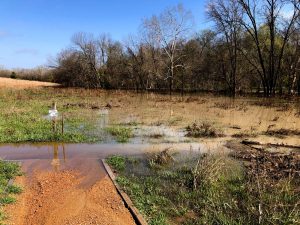 Runoff stormwater-related flooding is increasing at the Heard. Why? And why does this matter? Read on to learn more.
Runoff stormwater-related flooding is increasing at the Heard. Why? And why does this matter? Read on to learn more.
The Blackland Prairie Once Absorbed Much of Our Rainfall
Collin County is part of an ecoregion known as the Blackland Prairie. Native prairie plants have deep roots. Some of their roots can go as much as 30 feet deep, which allows them to absorb water that plants with shorter root systems can’t use. The stems and leaves also hold moisture. Scientists have estimated that an acre of prairie can intercept tons of water under certain conditions. (There are a few factors that I won’t elaborate on here for length, but if you’re interested in learning more, this guide has more information.)
However, the vast majority of the Blackland Prairie, once known for its rich soil, was converted to cropland over the last few centuries. Then, more recently, came residential and commercial development. As a result, less than 1% remains today, making it the most endangered large ecosystem in North America.
What Has Changed?
Over the last few decades, acres and acres of surfaces that don’t allow water to pass through have replaced these natural water-storing elements. These surfaces include roofs, driveways, parking lots, and roads. Even many lawns are designed to divert water quickly. While many of these elements are important to our safety (such as eliminating standing water in the streets), they also create massive runoff.
As you know, our region experienced flash flooding a few nights ago. While many of the effects around our homes have cleared away, downstream, the floodwaters are still receding. In recent years, as upstream development within the Wilson Creek watershed has increased runoff (for the reasons mentioned above), the Heard Wildlife Sanctuary has encountered more and more flooding like this downstream. These forces are highly destructive to our nature preserve, as you can see. The floodwaters rapidly erode the nature preserve, displace wildlife, kill plant life that isn’t adapted to flood conditions, leave behind trash, and more. They also can negatively affect the quality of the water we use for drinking.
But you can help! Learn how you can help slow runoff from your home and help others learn. An excellent first step is to observe how the water flows around where you live.
Here are a few more things you can do to help:
- plant native prairie plants back into your landscape
- install rain barrels to capture the runoff from your roof for later use
- reduce surfaces that don’t absorb water
- create a rain garden
